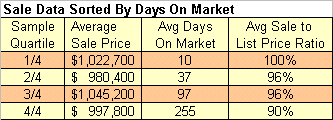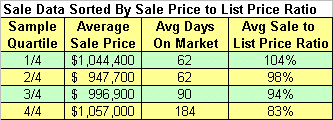 |
|
|
back
© 6/21/99
Time On The Market vs. Sale Price In The High-End Housing Market
Dear Clients & Friends,
Welcome, again, to the web-based issues of Housing Update. This letter will cover the relationship between 'pricing and time on the market' for the high-end housing market. For this research, high-end refers to inventory priced at $750,000 and up. The information presented here is relevant for extracting the highest net price for a property that comes to the market.
The data parameters for this research include sales and listings of existing single family residential listings located in King County that completed escrow after 1/1/98 and had a list price of $750,000 to $2,000,000. New homes were excluded from this study due to the fact that these properties are often listed prior to, or during construction, thus skewing the "time on market" issue discussed here.
Sellers typically try, and are entitled, to extract as much as possible from the marketplace when their property is listed. It's always a challenge to accurately price a new listing and especially so during a period of market volatility like we are now experiencing. The information that follows will help provide some perspective on the process of pricing a new listing and identify when to respond if offers are not forthcoming once there is 'sufficient' market exposure.
RESEARCH: There were about 1,700 off-market listings examined for this study. Of these, 38% (636) were closed transactions, 55% were unsuccessfully marketed (cancelled/expired etc.), and just under 8% were sold but not yet closed. Collectively, the 636 sold/closed transactions had an average sale price of $1,011,500, an average market time of 100 days, and an average "sale to original list price" ratio of 94.7%. However, the two tables that follow provide more insight into how the market functions and how/when sellers need to respond to the market's reaction to their property.
The 636 successfully marketed listings were sorted in ascending order by the number of days on the market, then divided into four (equal) quartiles. Their statistical characteristics are detailed in the table below. One noticeable item is that each successive group spends nearly triple the time on the market as the one before. Consider that the 6% spread in average prices in the first table may mean little if market appreciation is moving at 1% per month. This is particularly relevant for the fourth quartile (group 4/4), with 255 days/8.5 months of market exposure. Logically, the ratio of sale price to original list price drops with longer market exposure.
 The next table shows an analysis of the sale data after sorting by the ratio of "sale price to original list price," in descending order, then splitting the group into quartiles, again. For example, if a property is listed at $900,000 and is bid up to $925,000 this ratio would be about 103%. Based upon the sale data examined, both tables indicate that after about two months of exposure in a strong seller's market, it's probably time to get aggressive with pricing and adjust the numbers downward. The market is dynamic and even though there may be upward movement in prices, seasonal changes in the marketplace will likely occur and no guarantee of continued upward movement in prices while your listing is available exists.
 Of the 636 closed sales, 30% took more than one listing to successfully market and required two to three listing submissions to sell. Are they worth the time involved? You be the judge. It's my opinion that under current market conditions, if your high-end listing hasn't generated offers within four to six weeks of initial market exposure, then you need take a very critical look at the price, consider the comments from prospective buyers and their agents... and respond accordingly. In the lower price ranges, the period of initial exposure to test the market may be as short as two weeks in some sub-markets. COMMENTS FOR BUYERS & SELLERS ON USING AN AGENT: As seen above, even in a brisk market, not everything sells. Listing and selling houses is a very tough, emotionally grueling job. In my opinion, agent representation is an important element to 'successfully' completing this job. With high demand and limited inventory it may seem as though the expense of an agent's services is hard to justify. However, a GOOD agent who represents you well in negotiations is well worth their fee. Without third party representation, the more a buyer expresses interest in buying, or a seller in selling, the more their position is compromised during negotiations. Without third party representation, credible emotional distance can be hard to establish during the purchase or sale of a home. Face to face negotiations for the principals inherently sacrifices their respective positions. Also, with agent involvement, it is my opinion that sellers face less risk of litigation after the sale. And, if problems do arise, wouldn't you rather have a real estate firm with an Errors and Omissions insurance policy standing next to you? More importantly, a competent agent will likely help avoid problems that could lead to litigation. Buyers and sellers typically come into the real estate market once every five to ten years. With prices increasing at a steady pace, the stakes are increasingly high when buying and selling residential real estate. Pick an agent who is knowledgeable about the sub-market in which your property must compete. A good agent typically works hard for, and is well worth, their commission. It's money well spent! Regards,
Robert E. Rothstein
|
|
| Home | Housing Update Letters | Strand™ Index | Links | |
| ©1999 R.E. Rothstein | |